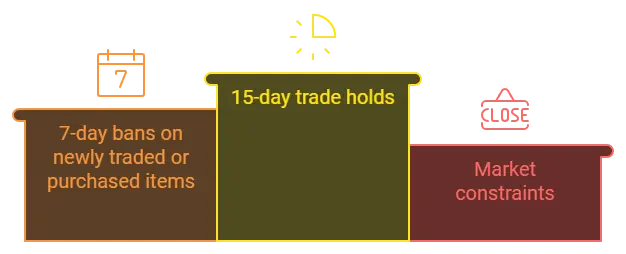Why Hide Tracks on CS:GO (CS2) Trades?

The world of CS skin trading has evolved into a dynamic and lucrative ecosystem, with millions of players participating in buying, selling, and trading virtual items. These trades often involve significant sums of money, making this ecosystem not only attractive but also highly competitive and complex. However, with its growth, the industry has also faced increasing challenges related to security, privacy, and compliance with Valve’s rules.
Traders must navigate a landscape where their activities are closely monitored, and violations can lead to severe consequences. In this context, some individuals resort to “hiding tracks” during trades. This raises an important question: Why do traders feel the need to hide tracks on CS trades?
Section 1: Understanding the Need to Hide Tracks
In the realm of CS trading, “hiding tracks” refers to the deliberate concealment of trading activities to avoid detection or scrutiny. This can involve using VPNs, altering trading patterns, or employing tools that obscure transaction histories.
The motivations behind hiding tracks vary, ranging from legitimate concerns over privacy and security to less ethical intentions like evading restrictions or covering up fraudulent activities. While some traders seek to protect their personal information or safeguard their investments, others may attempt to exploit loopholes in Valve’s systems or engage in illicit practices.
By understanding these motivations, we can shed light on why traders often feel compelled to operate in secrecy.
Section 2: Avoiding Detection of Suspicious Activity
Key Motivations
Valve employs sophisticated anti-fraud measures and automated detection systems to ensure the integrity of its trading ecosystem. These systems are designed to identify and flag activities that deviate from normal trading behavior.
Some behaviors that can trigger these systems include:
- Using multiple services simultaneously: Traders might access various trading platforms or bots, increasing the chances of being flagged for unusual activity.
- Engaging in high-volume trading: Rapid or bulk transactions can be seen as suspicious and indicative of bot usage.
- Frequent IP changes or use of VPNs: Altering IP addresses can signal an attempt to mask the trader’s identity or location.
Potential Consequences
When Valve’s systems detect suspicious activity, traders risk facing serious repercussions, such as:
- Account locks: Preventing the user from accessing their account until further verification.
- Trade bans: Blocking the ability to trade items, sometimes permanently, disrupting the trader’s operations and investments.
By concealing their tracks, traders aim to avoid these punitive measures, though such actions often come with risks of their own.
Section 3: Circumventing Trade Restrictions
Valve’s Restrictions
To maintain a fair and secure trading environment, Valve enforces several trade limitations. These include:
- 15-day trade holds: Transactions are placed on hold for two weeks unless users have two-factor authentication enabled.
- 7-day bans on newly traded or purchased items: Items become temporarily untradable to curb rapid reselling or fraudulent activities.
- Market constraints: Certain high-value or restricted items cannot be freely listed on the marketplace, creating challenges for traders who wish to liquidate or move them quickly.

These measures, while effective in deterring misuse, can also frustrate legitimate traders seeking flexibility and speed in their transactions.
Traders’ Tactics
To circumvent these restrictions, some traders adopt strategies to obscure their trading patterns, such as:
- Using intermediary accounts: Items are traded through multiple accounts to mask the original source.
- Engaging in off-platform trades: Utilizing third-party services or direct exchanges to bypass Valve’s marketplace entirely.
- Manipulating inventory visibility: Hiding inventory details to prevent Valve or other traders from tracking patterns that could reveal violations.
These tactics, while offering temporary solutions, carry risks of detection and penalty, further complicating the trading landscape.
Section 4: Evading Legal Consequences
Historical Context
The CS trading ecosystem has faced legal scrutiny, particularly in cases involving skin gambling sites. Valve has previously taken legal action against websites promoting gambling and other illicit activities tied to skins. Such actions underline the significant legal risks associated with exploiting the trading system for unlawful purposes.
Risk Factors
Individuals engaged in these illicit activities may resort to hiding their tracks to avoid:
- Legal repercussions: Including lawsuits, fines, or even criminal charges.
- Public exposure: Reputational damage can deter future involvement in the CS ecosystem or related ventures.
Techniques used include anonymizing transactions through VPNs, using multiple accounts, or utilizing off-platform tools to obscure the trail of involvement. These efforts highlight the high stakes for those operating on the fringes of legality within the trading community.
Section 5: Protecting Personal Information

High-Stakes Privacy Concerns
For traders dealing in high-value CS skins, privacy is a critical concern. Some skins are worth thousands of dollars, making traders potential targets for:
- Scams and phishing attempts: Fraudsters may exploit visible inventory details to execute scams.
- Inventory tracking: Competitors or malicious actors could monitor trading habits to gain an advantage or plan attacks.
- Direct theft: Hackers may breach accounts to steal valuable items.
Preventive Strategies
To safeguard their personal information, traders employ various tactics to hide their activities, such as:
- Disabling inventory visibility: Making inventories private to prevent others from monitoring trades.
- Using anonymous trading platforms: Opting for platforms that minimize data sharing or publicly visible histories.
- Strategic timing: Conducting trades at irregular intervals to make tracking more difficult.
These strategies not only help mitigate risks but also demonstrate the complexity of maintaining privacy in an increasingly transparent and competitive trading environment.
Section 6: Concealing Fraudulent Activities
Fraud in CS Trading
The CS trading ecosystem, while lucrative for legitimate traders, has also been plagued by high-profile scams and fraud. Among the most notable incidents was the 2022 theft of $6 million worth of skins from a prominent trading site. This event underscored the vulnerabilities within the system and the potential for exploitation by malicious actors.
Motivations of Malicious Actors
Fraudsters employ track-hiding techniques to:
- Evade detection: By obscuring transaction histories, scammers can avoid identification by victims or Valve’s security systems.
- Hinder recovery efforts: Concealing the movement of stolen items complicates efforts to trace and recover them.
- Facilitate future crimes: Maintaining anonymity allows fraudsters to remain active without drawing attention to past activities.
Common methods include trading through intermediary accounts, employing VPNs to disguise IP addresses, and utilizing off-platform trading channels to further complicate investigative efforts.
Section 7: The Consequences of Hiding Tracks
Hiding tracks in CS trading is not without significant risks and repercussions. Many methods used to obscure trading activities directly violate Valve’s terms of service.
Breaching Valve’s Terms of Service
Many methods used to obscure trading activities directly violate Valve’s terms of service, which prohibit:
- Circumvention of trading restrictions.
- Use of third-party software or tools to manipulate trading mechanics.
- Engaging in fraudulent or suspicious trading behavior.
Potential Repercussions
Traders caught hiding tracks may face:
- Trade bans: Temporary or permanent restrictions on their ability to trade skins.
- Account suspensions: Loss of access to Steam accounts, including other games and associated assets.
- Legal actions: For those involved in illicit activities, Valve may pursue legal measures.
These outcomes not only impact traders financially but also tarnish their reputation within the CS community.
Conclusion
The practice of hiding tracks in CS trading reflects the intricate balance between security, privacy, and compliance in a competitive ecosystem. While some motivations for hiding tracks may appear legitimate, many methods breach Valve’s guidelines and carry severe consequences.
Responsible trading practices are essential for maintaining a thriving, fair, and secure trading environment. Traders should prioritize transparency, adhere to Valve’s terms of service, and safeguard their personal and account security.
FAQ
Why do some traders hide their tracks in CS trades?
Traders hide their tracks for various reasons, including avoiding detection by Valve's anti-fraud systems, bypassing trade restrictions, protecting personal information, evading legal consequences, or concealing fraudulent activities.
Is hiding tracks in CS trading against Valve’s rules?
Yes, most methods used to obscure trading activity violate Valve’s terms of service. This includes attempts to bypass trade restrictions, use unauthorized tools, or engage in fraudulent behavior.
What are the risks of hiding tracks in CS trading?
Traders risk severe consequences such as trade bans, account suspensions, or even legal action for engaging in prohibited activities. These penalties can lead to the loss of valuable skins and damage to their reputation within the community.
How can I protect my personal information while trading CS skins?
To safeguard your privacy:
- Use secure trading platforms.
- Enable two-factor authentication (2FA).
- Avoid sharing your inventory or trade history publicly.
- Trade only with trusted users or verified services.
Are there legitimate reasons for hiding trading patterns?
While privacy concerns and protection against targeted attacks can be valid motivations, it’s essential to ensure that any actions taken comply with Valve’s terms of service to avoid repercussions.